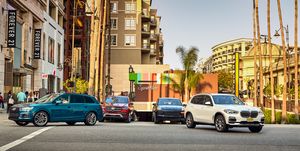
Austin IrwinCar and Driver
Introduction
When we got the go-ahead for a long-term 40,000-mile Porsche Cayenne, we pretty much knew what we wanted. Well, we knew at least whatever configuration we decided on would spark more than a few arguments among our staff. Because one of our favorite things to do is tinker with Porsche’s online car configurator, everyone here at C/D HQ had some idea what they wanted, individually. Coming to a consensus took some work.
When the dust settled, though, we ended up with a conservatively optioned Porsche SUV that felt like a suitable compromise. Technical editor and snowmobile-trailer-towing enthusiast David Beard was pleased with the $660 trailer hitch but irked that it does not come with a trailer wiring connector from the factory. The dealer charged us an additional $72 for a seven-pin connector that we installed ourselves. Beard also was put off that we didn’t get the $2000 off-road package for its skid plates, dash-mounted compass, and additional tow hook. (Beard’s typical weekend plans often include getting stuck in snow or mud.) What he didn’t realize is that the off-road package forces an additional $4490 in other upgrades, notably air springs, that we didn’t think were worth the upcharge. Our art department was happy that we spec’d the car in a sharp color, $800 Biscay Blue metallic. And everyone agreed that we needed Porsche’s superbly tuned adaptive dampers ($2000), the 14-way power-adjustable seats ($1900), and heated front seats ($530) to maximize the Cayenne’s comfort quotient.
We also agreed that we should get the new Porsche Surface Coated Brakes (PSCB.) Because science. Porsche claims these tungsten-carbide-coated rotors improve performance, and they better, what with 10-piston calipers squeezing 16.3-inch front rotors and 14.4-inch rotors with four-piston calipers in the rear. But, more important, they also reduce brake dust on the wheels. What we didn’t immediately realize is that those massive front discs won’t fit within the Cayenne’s stock 19-inch wheels. That meant the $3490 brake-hardware experiment grew by another $1720 for 20-inch Cayenne Design rollers. Porsche also may have snuck in the Sport Chrono Package ($1130) on us, but we’re not mad. Without it, we wouldn’t have launch control.
Special Delivery
All told, our entry-level 2019 Cayenne, which started at $66,950, rang in at $79,530. This is about the normal delta between base and as-tested prices that Porsche expects to see with its Cayenne models, only there won’t be too many Cayennes with PSCB out there. And if you’ve been following along with a calculator, as some of you do because we get the letters, you’ll notice that there is $350 left off the tally. That’s because we took part in the Porsche Experience Center Delivery, er, experience at PCNA’s headquarters in Atlanta.
For $350 (the price recently jumped to $395) you can fly to Atlanta (or Los Angeles, but that location is a little more expensive), get a behind-the-scenes tour of the Porsche center, receive 90 minutes of track instruction in a similar car, and eat lunch before a one-on-one walk-through of your vehicle with a product specialist. Our track-vehicle proxy was a Cayenne Turbo, and because Porsche SUVs ostensibly have some off-road capability, that 90-minute window also included some off-road instruction on a purpose-built obstacle course.
Porsche’s delivery process is an indulgence. For most people, it requires a flight and at least one night in a hotel, making it a luxury on top of an already luxurious purchase. But if you’ve been pining for a Porsche and ordered a car after spending weeks on the online configurator, it is a worthwhile reward.
Before we left Atlanta, we installed a set of OE-size Michelin Pilot Alpin 5 SUV winter tires, which are pretty quiet as far as winter tires go. Those set us back a not-insubstantial $1506 before installation, and some of that cost surely lies with these being N0-spec winters, meaning they are developed specifically for a Porsche.
On its stock Bridgestone Dueler H/P Sport summer tires, our 4708-pound Cayenne stops from 70 mph in 158 feet and holds onto the skidpad at 0.95 g. While those aren’t mind-blowing numbers, remember, this is just the base Cayenne model. With a modest 335 horsepower from its turbocharged 3.0-liter V-6, the Cayenne scoots to 60 in just 4.9 seconds and trips the quarter-mile lights in 13.5 seconds at 102 mph.
All of these performance numbers are in line with the other starter Cayenne that we previously tested, which also happened to be a comparison-test winning Cayenne. So, we have a good idea of what to expect. Despite our personal preferences, our long-termer surely will help make many of our upcoming fair-weather vacations more enjoyable ventures. Until then, however, it will continue to battle Michigan’s dreary, sloppy winter, probably with a snowmobile or two in tow.
Months in Fleet: 2 months Current Mileage: 6613 miles
Average Fuel Economy: 19 mpg
Fuel Tank Size: 23.7 gal Observed Fuel Range: 450 miles
Service: $0 Normal Wear: $0 Repair: $0
Damage and Destruction: $0
Source: Reviews - aranddriver.com





